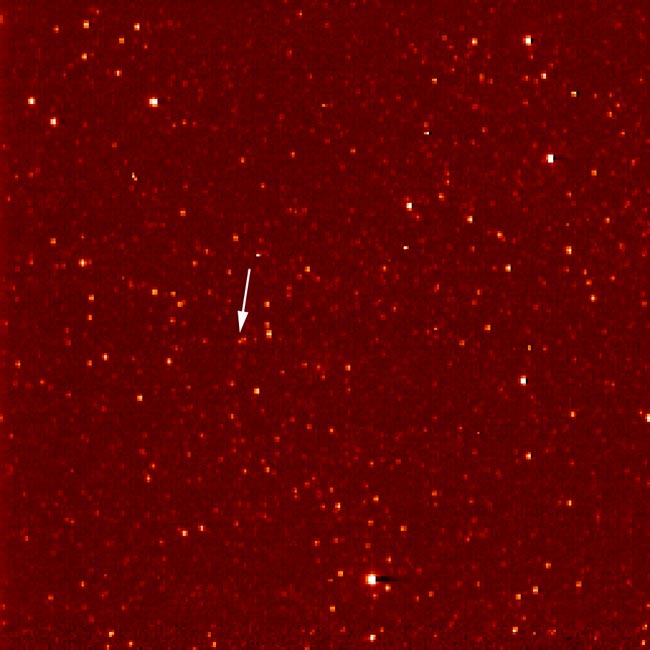Pluto-bound Spacecraft Spots its Target

A NASA spacecrafthurtling away from Earth has caughtthe first glimpse of its distant destination: the dwarf planet Pluto.
The NewHorizons probe, set to swing by Pluto and its moonsin 2015, plucked the small planet from a star-filled image during a checkoutperiod using the spacecraft's long range camera [image].
"Finding Plutoin this dense star field really was like trying to find a needle in a haystack,"said NewHorizons principal investigator Alan Stern, of the Southwest ResearchInstitute in Boulder, Colorado, in a statement.
Stern saidastronomers took a page from the book of the late skywatcherClyde Tombaugh--who discovered Pluto in 1930--and switchedbetween different images of the same area, taken days apart, to hunt for the planet.
But where Tombaugh used photographic plates, New Horizons researchersrelied on digital images taken of Pluto's expected location by their probe'sLong Range Reconnaissance Imager (LORRI). The small planet was easilyidentified as it moved against the background of stars.
"Wewon't get useful science out of these first detections of Pluto," Sternsaid. "But during the next several years of approach, we'll use LORRI tostudy Pluto's brightness variation with our angle to the Sun to build a 'phasecurve' we could never get from Earth or Earth orbit."
Thatshould yield new details of Pluto's frigid surface well before New Horizonsmakes its flyby past the dwarf planet on July 14, 2015, he added.
Get the Space.com Newsletter
Breaking space news, the latest updates on rocket launches, skywatching events and more!
Inthe meantime, New Horizons researchers are content to know that the probe'slong-distance camera is working well, and eagerly awaiting next year's Feb.28slingshot past Jupiter. Thespacecraft was built for NASA by Johns Hopkins Applied Physics Laboratory,which is also managing the mission's more than nine-year flight.
Travelogue to Pluto
Sinceits Jan.19launch, New Horizons has snapped photos of the asteroid JF56--during a June13 pass--as well as the starMessier 7 and the gasgiant Jupiter on its way to Pluto.
ThePluto portrait was taken between Sept. 21-24, storedaboard New Horizons and only recently relayed back home to Earth. New Horizonswas about 2.6 billion miles (4.2 billion kilometers) from its planetary targetat the time of the LORRI image.
"Thoseof us who calibrated LORRI on the ground and in flight are not surprised to seewhat it can do, but we are mighty grateful that LORRI has survived launch andits first several months in space without any loss of performance," said LORRIprincipal investigator Andy Cheng, of the Applied Physics Laboratory, in astatement.
NASAhas billed New Horizons' journey as the U.S. space agency's fastest mission todate despite its long travel time. Stern and his fellow mission scientists arehoping to send their spacecraft past Pluto to visit at least one other icyobject in the distant Kuiper Belt, which stretches beyond the orbit of Neptune. [Click herefor a graphic of the probe's flight path.]
New Horizonsis currently speeding through the solar system at about 20.8 kilometers persecond with respect to the Sun. That's about 46,528 miles per hour (74,880kilometers per hour).
- Why Planets Will Never Be Defined
- Pluto Demoted: No Longer a Planet in Highly Controversial Definition
- IMAGES: NASA's New Horizons Mission
- Reaching for the Edge: Complete Coverage of New Horizon's Pluto-bound Mission
- All About Pluto
Join our Space Forums to keep talking space on the latest missions, night sky and more! And if you have a news tip, correction or comment, let us know at: community@space.com.

Tariq is the Editor-in-Chief of Space.com and joined the team in 2001, first as an intern and staff writer, and later as an editor. He covers human spaceflight, exploration and space science, as well as skywatching and entertainment. He became Space.com's Managing Editor in 2009 and Editor-in-Chief in 2019. Before joining Space.com, Tariq was a staff reporter for The Los Angeles Times covering education and city beats in La Habra, Fullerton and Huntington Beach. In October 2022, Tariq received the Harry Kolcum Award for excellence in space reporting from the National Space Club Florida Committee. He is also an Eagle Scout (yes, he has the Space Exploration merit badge) and went to Space Camp four times as a kid and a fifth time as an adult. He has journalism degrees from the University of Southern California and New York University. You can find Tariq at Space.com and as the co-host to the This Week In Space podcast with space historian Rod Pyle on the TWiT network. To see his latest project, you can follow Tariq on Twitter @tariqjmalik.









